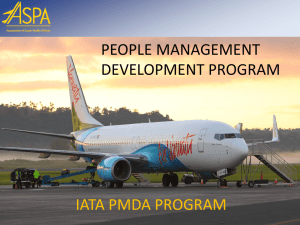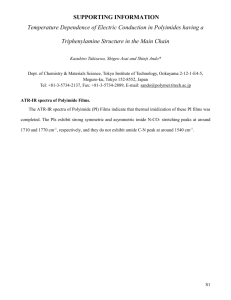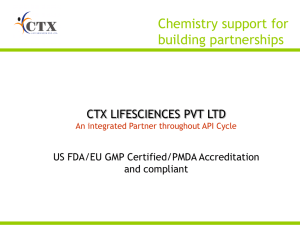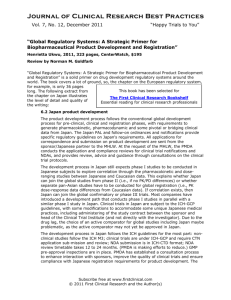Pioneering Regenerative Medicine: Trends in Regulations for New
advertisement
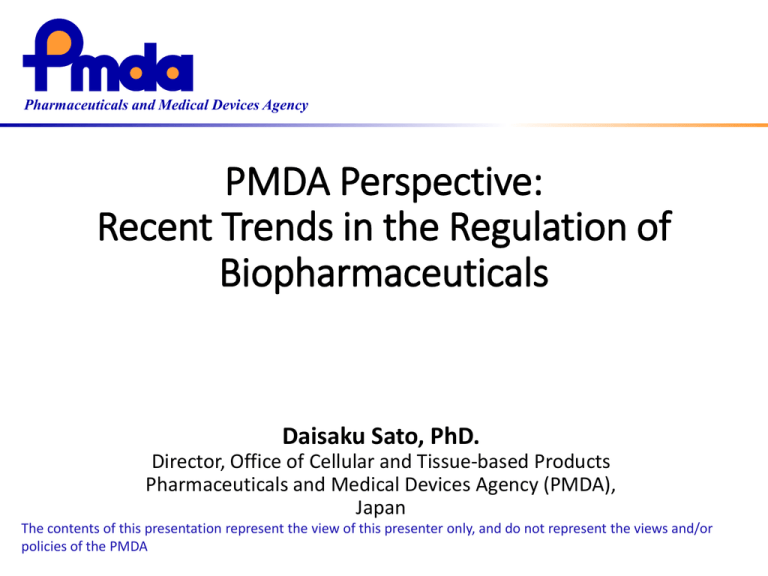
Pharmaceuticals and Medical Devices Agency PMDA Perspective: Recent Trends in the Regulation of Biopharmaceuticals Daisaku Sato, PhD. Director, Office of Cellular and Tissue-based Products Pharmaceuticals and Medical Devices Agency (PMDA), Japan The contents of this presentation represent the view of this presenter only, and do not represent the views and/or policies of the PMDA CONTENTS • PMDA’s Structure, Policy and Trend • Antibody Engineering Technologies and Products: (1) Current Status and Future Prospects (2) Recent Trends in the Regulation of Biopharmaceutical Products • New Regulations for Cellular and Tissue-based Products (incl. quality evaluation) • Accelerated Developing Programs (CMC Consideration) • Lifecycle Approach to Process Validation Pharmaceuticals and Medical Devices Agency Major Services 3 Scientific Review for Drugs & Medical Devices GCP, GMP Inspection Consultation on Clinical Trials Safety Measures Relief Services Unique Three-pillar System Securing Nation’s Safety Review Japanese citizens Kansai Branch Safety Relief 4 Organization of PMDA Associate Center Director Executive Director Office of Regulatory Science Office of Standards and Guidelines Development Associate Executive Director Director of Center for Product Evaluation Office of Review Administration Office of Review Management Office of International Programs Associate Executive Director International Coordination/Liaison Officers Offices of New Drug I-V Associate Center Director Deputy Center Director (for Cellular and Tissuebased Products) Chief Executive Associate Center Director Office of Cellular and Tissue-based Products Office of Vaccines and Blood Products Offices of OTC/Quasi-Drugs Office of Generic Drugs Associate Executive Director Offices of Medical Devices I-III Deputy Center Director (for Medical Devices) Auditor Auditor Office of Conformity Audit Principal Senior Scientists Senior Scientists Associate Center Director Senior Executive Director Advanced Review with Electric Data Promotion Group Kansai Branch Office of Manufacturing/ Quality and Compliance Chief Safety Officer Offices of Safety I, II Associate Executive Director Audit Office Executive Director Chief Actuary Chief Relief Officer As of November 1, 2014 Deputy Executive Director Information Technology Promotion Group Chief Management Officer Office of Relief Funds Offices of General Affairs / Office of Financial Management / Office of Planning and Coordination 3rd 5-year mid-term Plan of PMDA (FY2014-2018) Major challenges Shortening the time to approval High quality review/consultation services Enhancing safety measures Globalization Specific measures Accelerated review process (Improvement of approval predictability) Improvement of prior assessment (substantial acceleration of approval review process) Introduction of approval system with condition/ period for Regenerative Medicines Drastic improvement of consultation service •Improvement of pharmaceutical affairs consultation service on R&D strategy •Improvement of clinical trial consultation service Advanced Review/Consultation System Readiness for introduction of RMP Utilization of medical inf. database Goal •Development of Japan’s original innovative drugs and medical devices •Marketing of cellular and tissue-based products Human Resources with excellent skills (751 staffs →1065 staffs) •Activation of industry •Extending health and life span of Japanese people •Contribution to global medicine Accelerating Review Period Total Review Period New Drug (Standard) 30 20 Total Review Period New Drug (Priority) 40 30 20 20 20 15 15 11.2 10.6 8.5 10 6.7 12.9 10.8 9.1 5.8 5.6 10 10 5.5 0 9 0 5 7.7 0 2014 2015 2016 2017 2018 5.3 8.1 1.6 Percentile 2013 10 7.7 Total Review Period Standard 50 60 70 70 80 80 12mo. Priority 50 60 60 70 70 80 9 mo. 5.5 3.6 4.6 3.3 5 0 Regulatory Applicant Number of application Target Period PMDA Staff Size 1200 Administrative part Review Department 1000 Safety Department Planned 800 1065 753 648 678 702 605 600 521 426 400 256 291 319 341 200 0 2004.4 2005.4 2006.4 2007.4 2008.4 2009.4 2010.4 2011.4 2012.4 2013.4 2014.4 2018 CONTENTS • PMDA’s Structure, Policy and Trend • Antibody Engineering Technologies and Products: (1) Current Status and Future Prospects (2) Recent Trends in the Regulation of Biopharmaceutical Products • New Regulations for Cellular and Tissue-based Products (incl. quality evaluation) • Accelerated Developing Programs (CMC consideration and product life cycle) mAbs & Fusion proteins account for more than 25% No. of approved recombinant protein products 100 90 mAbs, Fusion proteins, 28 80 70 60 Cytokines, 8 50 EPOs, 5 Interferons, 7 Vaccines, 4 40 30 Hormones, 25 20 Coagulation factors, Albumin, 6 10 Enzymes, 11 0 1985-2000 1985-2013 As of September 1, 2013 Quality by Design (Q8(R2)) • Quality cannot be tested into products; i.e., quality should be built in by design. • A systematic approach to development • Begins with predefined objectives and emphasizes product and process understanding and process control • Based on sound science and quality risk management. QbD is useful tool for understanding quality of biotech products Key Consideration of QbD Approach QTPP Identify the critical quality attributes based on the potential risks CQAs Risk Management Control Strategy Continual improvement Linking material attributes and process parameters to CQAs, in this case, risk assessment is useful Establishment and implementation of control strategy Knowledge and understanding obtained could facilitate continual improvement QbD Assessment Project • In November 2011, PMDA launched a new project team to handle the participation in the EMA-FDA pilot program as an observer. • The project team consists of reviewers, inspectors, etc.. What PMDA learned • Although regulatory actions, especially post approval change procedure, might be a little different among regulatory agencies, • post-approval changes will be well accommodated by QbD to minimize post-approval change application/notification process. QbD gives more flexibility in Post-approval changes in Japan? <Quality information> Application Form •Specification •Mfg. process •etc. Module 2 (QOS) Module 3 Matters for Partial Change Application (PCA) Matters for Partial Change Application (PCA) Matters for Minor Change Notification (MCN) Matters for Minor Change Notification (MCN) •Mfg. process •Process characterization •etc. •Mfg. process •Process characterization •etc. QbD gives more flexibility in Post-approval changes in Japan? <Quality information> PCA Application Form Module 2 (QOS) Module 3 •Specification •Mfg. process •etc. •Mfg. process •Process characterization •etc. •Mfg. process •Process characterization •etc. MCN Regulatory History and Status of Biosimilars • Application Category for biosimilars • Guideline • Nomenclature rules Q&A Q&A 2005 2009 2010 2011 Somatropin BS [Sandoz] Epoetin alfa BS [JCR] Revision of Nomenclature rules 2012 2013 2014 Filgrastim BS [Sandoz] Filgrastim BS [F], Infliximab BS [MOCHIDA]Filgrastim BS [NK], [CTH] [NK], [TEVA] List of Approved Biosimilars in Japan Drug name Somatropin BS S.C. Injection 5mg [SANDOZ] etc.* Epoetin alfa BS Injection 750 syringe [JCR] etc. * Filgrastim BS Injection 75µg syringe [F] / [MOCHIDA] etc.* Filgrastim BS Injection 75µg syringe [NK] / [TEVA] etc.* Filgrastim BS Injection 75µg syringe [SANDOZ] etc.* Infliximab BS I.V. infusion 100mg [NK] / [CTH] *: etc. means different presentations. Japanese Accepted Name Manufacturer (JAN) Somatropin (genetical recombination) SANDOZ Epoetin Kappa (genetical recombination) [Epoetin Alfa Biosimilar 1] Filgrastim (genetical recombination) [Filgrastim Biosimilar 1] Filgrastim (genetical recombination) [Filgrastim Biosimilar 2] Filgrastim (genetical recombination) [Filgrastim Biosimilar 3] Infliximab (genetical recombination) [Infliximab Biosimilar 1] Reference product Approved year Genotropin (Somatropin) (Pfizer) 2009.5 JCR Pharmaceuticals Espo (Epoetin alfa) (Kyowa Hakko Kirin) 2010.1 Fuji Pharma / Mochida Pharmaceutical Gran (Filgrastim) (Kyowa Hakko Kirin) 2012.11 NIPPON KAYAKU / Gran (Filgrastim) Teva Pharma Japan (Kyowa Hakko Kirin) 2013.2 SANDOZ Gran (Filgrastim) (Kyowa Hakko Kirin) 2014.3 NIPPON KAYAKU / Celltrion Remicade (Infliximab) (Mitsubishi Tanabe Pharma) 2014.7 Regulations for Biosimilars in Japan • Guideline for the Quality, Safety and Efficacy Assurance of Follow-on Biologics (FOBs)* (PFSB/ELD Notification No. 0304007 / March 4, 2009) http://www.pmda.go.jp/english/service/pdf/notifications/PFSB-ELD-0304007.pdf (GL in English) with Overview of comments on Guideline *: “Follow-on Biologics” in this guideline is a synonym for “Biosimilars”. • Marketing Approval Application for FOBs (PFSB Notification 0304004 / March 4, 2009) • Nonproprietary Name and Drug Name of FOBs (PFSB/ELD Notification No. 0214-1, Administrative Notice / February 14, 2013) • Questions & Answers regarding Guideline (PFSB/ELD Administrative Notice / July 21, 2009, March 31, 2010) • Risk management plan (RMP) guidance PFSB/ELD Notification No. 0411-1, 0411-2 Administrative Notice / April 11, 2012 • RMP should be considered at the time of submission of approval application for biosimilar Number of Consultation for Biosimilars No. of consultations 25 20 15 10 5 0 2006 2007 2008 2009 2010 Fiscal year 2011 2012 2013 (from April 1 to March 31) Based on date of application Consultation on Clinical Trial Trend of Clinical Trial Consultation 450 32.1 30 29.9 29.5 28.4 27.0 % of Global Clinical Trials 25 400 (* ) 23.8 300 20 15 350 250 281 315 336 359 411 361 312 200 150 10 100 5 50 0 0 FY2007 FY2008 FY2009 FY2010 FY2011 FY2012 FY2013 Fiscal Year; Start from April Number of Clinical Trial Consultation % of Global Clinical Trials Number of Clinical Trial Consultation 35 *:Currently calculating Clinical Trial The acceptability of foreign clinical data • Ref. to ICH guideline E5 (R1) Global clinical trial • It is important that the consistency between entire population and the Japanese population could be explained from the results. • Ref. to Basic Principles on Global clinical trials http://www.pmda.go.jp/english/service/pdf/notificatio ns/PFSB- ELD-0928010.pdf Requirement of Japanese data Global Issues to be addressed i. ii. iii. iv. v. vi. vii. Can a sponsor use non-XXX sourced reference product in comparability exercise? Is toxicity study (repeat-dose toxicity study) required for biosimilar development? What should a sponsor consider when designing the efficacy trials? Is regional data required for biosimilar development? What should a sponsor consider when designing global clinical trial? Is extrapolation of indications acceptable? What is the rule of biosimilar naming? Reference Product (1) Guideline: The reference product (RP) should be already approved in Japan. • PMDA thinks the sponsor should confirm the comparability to the RP which is approved (and used by healthcare providers and patients) in Japan. Reference Product (2) • However, if a sponsor needs to use non Japan-sourced RP in comparability exercise, it is required to explain that the nonJapan sourced RP is the representative of the Japan sourced RP by analytical assays and publicly available information. …. Biosimilar non-Japan sourced RP Japan sourced RP CONTENTS • PMDA’s Structure, Policy and Trend • Antibody Engineering Technologies and Products: (1) Current Status and Future Prospects (2) Recent Trends in the Regulation of Biopharmaceutical Products • New Regulations for Cellular and Tissue-based Products (incl. quality evaluation) • Accelerated Developing Programs (CMC consideration and product life cycle) New Legislative Framework These two acts were promulgated in November 2013 by the Japanese Diet (Parliament) in line with the Regenerative Medicine Promotion Act, in order to reform the pharmaceutical and medical regulation related to regenerative medicine • Revision of the Pharmaceutical Affaires Law: The Pharmaceuticals, Medical Devices, and Other Therapeutic Products Act (PMD. Act) • The Act on the Safety of Regenerative Medicine These two acts are scheduled to be enacted on 25 November 2014 Other related governmental policy: • Healthcare and Medical Strategy Promotion Act (2014.5) • Japan Medical Research Development Institution Act (2014.5) Revision of Pharmaceutical Affairs Law Revisions of Drugs and Medical Devices Articles • • Relevant party’s obligations are specified to ensure quality, safety, and efficacy of drugs and medical devices. MAH’s obligation to notify labeling and its revision, reflecting the latest findings Revisions of Medical Devices Articles • • • • Independent Chapter for “Medical Devices” Expansion of Third party certification system to higher risk devices Quality Management System (QMS) adherent to ISO 13485 Other revisions related to medical devices Additions for Regenerative Medical Products • Definition and independent chapter for Regenerative Medical Products • Introduction of conditional/time limited approval system Definition of “Regenerative Medical Products” in Japanese Legislation • Regenerative medical products are defined as processed human/annimal cells that are intended to be used 1) for either (1) the reconstruction,repair, or formation of structures or functions of the human body or (2) the treatment or prevention of human diseases,or 2) for gene therapy. . =. Under the Revised PAL (=Pharmaceuticals and Medical Devices Act. (PMD Act.) ) Cellular and Tissue based Products and Gene therapy Products . =. Advanced-therapy medicinal products (ATMPs) Regulation (EC) No 1394/2007 Two Authorized Products under PAL Ref. Japan Tissue Engineering Co., Ltd. (J-TEC), HP Autologous Culture Epidermis JACE Indication: serious burns treatment (limited to the burns of more than 30% of the body surface area) Marketing authorization for medical device on 29 October 2007 (submission: 6 October 2004) Autologous Cultured Cartilage JACC Marketing authorization for medical device on 27 July 2012 (submission: 24 August 2009) 29 Indication: Relief of symptoms of traumatic cartilage defects and osteochondritis dissecans (exclude osteoarthritis) for knee joints. (limited to a defect area of over 4cm2 with no alternative therapy.) Two of the New Products Application under the New Regulation during grace period • According to the news released by the sponsor companies, in September and in October 2014, two new product applications for marketing authorization were filed by PMDA 1. Bone marrow mesenchymal stem cells for GVHD 2. Skeletal myoblast sheet for serious heart failure due to ischemic heart disease Note: Figures quoted from the company press release docs Early Access Schemes of ICH 3 parties US EU JAPAN Priority Review Priority review Accelerated approval for Conditional MA serious or lifeMA under exceptional threatening illnesses circumstances Conditional Approval for Oncology drug, Orphan drug Conditional & Timelimited approval for regenerative medicine Break through therapy & Fast Track designation Forerunner Review Assignment Various agencies have various approaches to accommodate patient access though they have certain similarity. How to expedite R&D and review for cellular and tissue based product • Designed for unmet needs under the present treatment: limited number of patients available for CT • Difficult to conduct controlled study to demonstrate “true end point” of clinical benefit • Heterogeneity of Quality affected by source materials Would it take long time for CTs and review if regulator pursues the conventional drug pathway too much? The Pharmaceuticals and Medical Devices Act (PMD Act) Separate category and definition of “regenerative medical products” Difficult to gather and evaluate the data for efficacy of regenerative medical products in a short time due to heterogeneity of cells To secure timely provision of safe regenerative medicines, a new regulatory framework is needed Expedited approval system for regenerative medical products After the safety is confirmed and the results predict likely efficacy, the product will be given conditional, time-limited marketing authorization in order to enable timely provision of the products to patients. Expedited approval system under PMD Act [Traditional approval process] Clinical study < Drawback of traditional PAL approval system > Long-term data collection and evaluation in clinical trials, due to the characteristics of cellular/tissue-based products, such as non-uniform quality reflecting individual heterogeneity of autologous donor patients Phased clinical trials (confirmation of efficacy and safety) Marketing authorizati on Marketing [New scheme for regenerative medical products] Clinical trials Clinical study (likely to predict efficacy, confirming safety) Conditional /term-limited authorization Marketing (Further confirmation of efficacy and safety) Marketing authorization or Revocation Marketing continues Post-marketing safety measures must be taken, including prior informed consent of risk to patients 34 Likely to predict efficacy (clinical benefit) • To approve products based on the limited data, such as surrogate endpoints in exploratory study. • Similarity to accelerated approval of USFDA * The product has an effect on a surrogate endpoint that is reasonably likely to predict clinical benefit (ref.) • We have experiences in the orphan drug area. Ref.) USFDA--Accelerated Approval of New Drugs for Serious or LifeThreatening Illnesses (57 FR 58958, Dec. 11, 1992) • • • • • • It applies to certain new drug products in treating serious or life-threatening illnesses and that provide meaningful therapeutic benefit to patients over existing treatments. Approval based on a surrogate endpoint or on an effect on a clinical endpoint other than survival or irreversible morbidity. The drug product has an effect on a surrogate endpoint that is reasonably likely to predict clinical benefit or on the basis of an effect on a clinical endpoint other than survival or irreversible morbidity.. Approval will be subject to the requirement that the applicant study the drug further, to verify and describe its clinical benefit (such as OS). Postmarketing studies would usually be studies already underway. FDA may withdraw approval, if a postmarketing clinical study fails to verify clinical benefit; …………. Outcome of the Science Board Cellular & Tissue-based Products • Current Perspective on Evaluation of Tumorigenicity of Cellular and Tissue-based Products Derived from iPSCs and iPSCs as Their Starting Materials (Aug. 21, 2013) Pharmaceuticals, Bio-based Products • Summary of Discussion on Non-clinical Pharmacology Studies of Anticancer Drugs (Dec. 10, 2013) • Summary of the discussion on assessment of the current status of personalized medicine relating to drug development and review (Mar. 11, 2014) 17 The Science board discussion, further • Further to the discussion in the last term, in the present term following immediate discussion is on-going to support scientific consultations and reviews of PMDA: 1. Drugs Necessity and condition of placebo-controlled trials for diseases under unmet medical needs Effective utilization animal models for non-clinical testing to demonstrate POCs 2. Medical Devices Application of numerical analysis for non-clinical testing Evaluation of medical devices for pediatric use (including application of non-clinical testing) 3. Cellular & tissue-based products Manufacturing and quality of cellular products during the early development in cell processing centers CONTENTS • PMDA’s Structure, Policy and Trend • Antibody Engineering Technologies and Products: (1) Current Status and Future Prospects (2) Recent Trends in the Regulation of Biopharmaceutical Products • New Regulations for Cellular and Tissue-based Products (incl. quality evaluation) • Accelerated Developing Programs (CMC consideration and product life cycle) Forerunner Package Strategy http://www.mhlw.go.jp/english/policy/health-medical/pharmaceuticals/140729-01.html Forerunner Review Assignment System Forerunner Review Assignment System is a system to put innovative medicines/medical devices/regenerative medicines originated from Japan into practice. Designation Criteria Medical products for diseases in dire need of innovative therapy and satisfies the following two conditions: 1. Having developed firstly in Japan and anticipating an application for approvals (desirable to have PMDA consultation from the beginning of R&D) 2. Prominent effectiveness (i.e. radical improvement compared to existing therapy), can be expected based on the data of mechanism of action from non-clinical study and early phase of clinical trials (phase I to II) Not limited to life-threatening and regenerative medicine General Timeframe of Forerunner Review Assignment Designation Advantage 【Review under FORRUNNER SCHEME】 Consultation Forerunner Assignment 6 months Prior Review (rolling submission) Review Priority Review Review ahead of schedule Non-clinical research/ Clinical research Clinical Trial Phase I/II Consultation on Clinical Trial 1 month Clinical Trial Phase III ※May accept Phase III data during review, depending on conditions reimburs ement PostMarketing strengthening postmarketing safety • Shorten review time, using rolling submission of data as “prior review” during P-III • Similar to break through therapy designation of USFDA • Come Into effect in early 2015 Overall picture of CMC development 【Typical Development】 NonClinical Study Target product Profile Control strategy Phase 1 Clinical Study Phase 2 Approval Accelerated Phasereview 3 approval timeline Establishment of Design Quality and Product Quality by CMC study Control strategy PostApproval Process Validation Control strategy Quality Attributes CQA Process Parameters CPP Consistency Control Strategy Equivalency Knowledge Control/Quality Risk Management Investigational Product GMP GMP 42 CMC Challenges for Consideration on Early Approval (much relies on post-approval change ) • Experience of manufacturing is limited with small number of batches for clinical trial in terms of specification Considering number of batches to be tested for CMC development? Look at the product life cycle management in post-approval change control. • Stability testing may not meet the conventional requirements consider robustness of severe test and acceleration test data for acceptance • When process validation should be conducted during the review, would be time limiting. validation vs. verification Consider similarity to the transfer from investigational drug batches to commercial butches (continuous process verification) Knowledge management in the lifecycle Overall picture of CMC activities through the product life cycle Cycle that connects development and commercial production Product Quality Review Process Research Commercial Production Process Validation Knowledge Quality Improvement Post-approval change Technical Transfer Development Report of Research and Development Post-Approval Change Procedure Risk of Changes Japan US EU High Partial change (Application for approval of variation) Major change (Prior approval supplement) Type II variation (Application for approval of variation) Moderate Minor change (Notification within 30 days after implementation or shipping) Moderate change 1)Supplementchanges being effected (CBE) in 30 days Type IB variation (Notification before implementation and MAHs must wait a period of 30 days) 2)Supplementchanges being effected (CBE) Minor change (Annual report) Type IAIN variation (Immediate notification) Low SOP (Under GMP change control) Type IA variation (Notification within 12 months after implementation) Further international arrangement would be needed? • Timeframe and regulatory actions for post-approval change would be coordinated • Consultation between regulators and sponsors would be encouraged in a timely manner. Then, international cooperation, including among regulatory authorities, will be more vital in the biologics area. Japan Approved Member at the 38th PIC/S Committee Meeting Japan(MHLW, PMDA, 47 prefectures) GMP Inspectors applied for PIC/S membership on March 2012 On-site examination on September 9-13, 2013 Decided to become official membership on July 1st 2014 at the committee meeting on may 15-16, 2014(Rome) 45th member With PIC/S Chair Dr. Joey Gouws Basic requirements of Validation to Scheme) respond PIC/S(Pharmaceutical InspectionInternationally Convention and Co-operation :Cooperative framework between inspectors aimed to achieve harmonized GMP toGMP global biologics quality standards within the pharmaceutical area and the international development, enforcement, and conservation of the quality system. PIC/S is emerging to become the world standard in the GMP domain. Global Activities Summit ICH IMDRF PIC/S APEC LSIF RHSC OECD PDG IDGRP Abbreviation Summit ICH IMDRF PIC/S HBD APEC LSIF RHSC OECD MAD PDG IGDRP HBD and more… Official Name International Summit of Heads of Medicines Regulatory Agencies International Conference on Harmonization International Medical Device Regulators Forum Pharmaceutical Inspection Convention and Pharmaceutical Inspection Co-operation Scheme Harmonization By Doing APEC Life Science Innovation Forum Regulatory Harmonization Steering Committee OECD Mutual Acceptance of Data Pharmacopoeial Discussion Group International Generic Drug Regulators Pilot PMDA and the World Confidentiality Arrangement Memorandum of Understanding (MOU) Resident Staff Joint Symposium (forth coming) Health Canada, Canada PMDA Tokyo & Osaka, Japan EMA(EU) FDA, US CFDA, * China IMB, Ireland ANVISA, Brazil MHRA, UK TFDA, Thailand CBG-MEB, Netherlands ANSM, France Swissmedic, Switzerland AIFA, Italy • • HSA, Singapore Taiwan FDA, ** Taiwan NADFC, Indonesia TGA, Australia MOU between the Chinese SFDA (present CFDA) and the Japanese MHLW, under which PMDA supports cooperative activities ** MOU concluded between Interchange Association and East Asia Relations Commission, but is being implemented through cooperation of related organizations. 49 Thank you for your attention Daisaku Sato, PhD. Director, Office of Cellular and Tissue-based Products Pharmaceuticals and Medical Devices Agency (PMDA), Japan sato-daisaku@pmda.go.jp Regenerative medicine literature available in English Hara A. Sato D. Sahara Y. New Governmental Regulatory System for Stem Cell–Based Therapies in Japan. Therapeutic Innovation & Regulatory Science. 2014; 48(6): 681-688. 50
